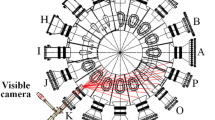Abstract
Plasma facing components (PFCs) for the fusion device are employed to sustain the heat flux (10–20 MW/m2) and plasma particle flux in steady-state and transient conditions. Therefore, the performance of the PFCs is essential to maintain safe operation of the reactor. Before installation of the PFCs, the defects must be detected. Infrared non-destructive examination method is a novel non-destructive detection, having the advantages of non-contact, large detection area, fast detection, visual examination result. The active infrared non-destructive examination technology has been developed based on the structural feature of the PFCs and the active infrared thermograph facility is established. Experimental study is conducted with W/Cu PFCs samples with different sizes of artificial defects and with no defects, in which the infrared thermograph images are obtained. The detecting ability of the infrared non-destructive examination is evaluated by analyzing the temperature distribution of the samples. Based on the study of infrared thermograph processing methods, surface temperature error of the samples caused by uneven emissivity can be eliminated by maximum temperature deviation reconstruction method. Furthermore, fast discrete Fourier transform method can help increase the signal-to-noise ratio and realize defects distinguishment. As the supplementary of the experiments, numerical simulation is used to investigate the key influences of the active infrared non-destructive examination method with the finite element model for samples with different defect locations, defects sizes, mass flow rate of the coolant and the temperature of the coolant.

















Similar content being viewed by others
References
G.N. Luo, X.D. Zhang, D.M. Yao et al., Overview of plasma-facing materials and components for EAST. Phys. Scr. 128, 1–5 (2007)
Tomoaki Hino, Japanese universities’ activities for PFC development and PMI studies. Fusion Eng. Des. 39–44, 439–444 (1998)
M. Merola, D. Loesser, A. Martin et al., ITER plasma-facing components. Fusion Eng. Des. 85(10), 2312–2322 (2010)
P. Qi, Q. Li, X.J. Kuang et al., Quality control of interface between tungsten coating and Cu alloy heat sink of PFC for EAST Tokamak by infrared thermography. ASME Conf. Proc. (2010). doi:10.1115/ICONE18-29435
J.W. Davis, P.D. Smith, ITER material properties handbook. J. Nucl. Mater. 233, 1593–1596 (1996)
A. Durocher, F. Escourbiac, M. Richou, Infrared thermography inspection of the ITER vertical target qualification prototypes manufactured by European industry using SATIR. Fusion Eng. Des. 84(2), 314–318 (2009)
F. Escourbiac, S. Constans, X. Courtois et al., Application of lock-in thermography nondestructive technique to CFC armoured plasma facing components. J. Nucl. Mater. 367, 1492–1496 (2007)
X. Courtois, A. Durocher, M. Lipa, Health monitoring of Tore-Supra toroidal pump limiter using lock-in thermography. Fusion Eng. Des. 84(2), 628–631 (2009)
C. Meola, G.M. Carlomagno, A. Squillace et al., Non-destructive evaluation of aerospace materials with lock-in thermography. Eng. Fail. Anal. 13(3), 380–388 (2006)
A. Durocher, J. Schlosser, J.J. Cordier et al., Quality control of plasma facing components for Tore Supra. Fusion Eng. Des. 66, 305–309 (2003)
F. Cismondi, B. Xerri, C. Jauffret et al., Analysis of SATIR test for the qualification of high heat flux components: defect detection and classification by signal-to-noise ratio maximization. Phys. Scr. T128, 213 (2007)
K. Ezato, M. Dairaku, M. Taniguchi et al., Non-destructive testing of CFC monoblock divertor mock-ups. J. Nucl. Mater. 307, 144–148 (2002)
P. Chaudhuri, P. Santra, S. Yeole et al., Inspection of brazed joints between cooling tube and heat sink of PFC for SST-1 tokamak by IR thermography technique. Fusion Eng. Des. 73(2), 375–382 (2005)
Acknowledgments
This work was supported by the National Magnetic Confinement Fusion Science Program of China (2013GB114005) and the National Natural Science Foundation of China (11375116).
Author information
Authors and Affiliations
Corresponding author
Rights and permissions
About this article
Cite this article
You, X., Hu, X. & Tong, L. W/Cu PFCs Defects Detection with Infrared Non-destructive Examination Method for EAST. J Fusion Energ 34, 671–678 (2015). https://doi.org/10.1007/s10894-015-9866-y
Published:
Issue Date:
DOI: https://doi.org/10.1007/s10894-015-9866-y




